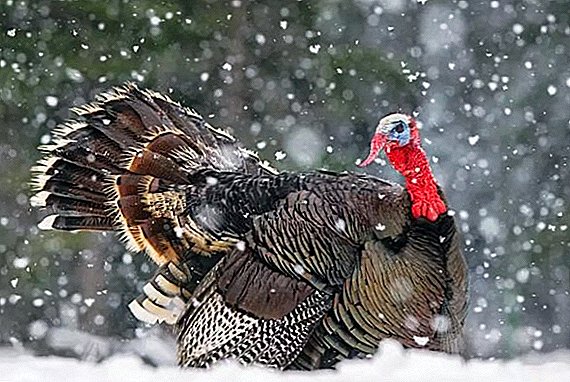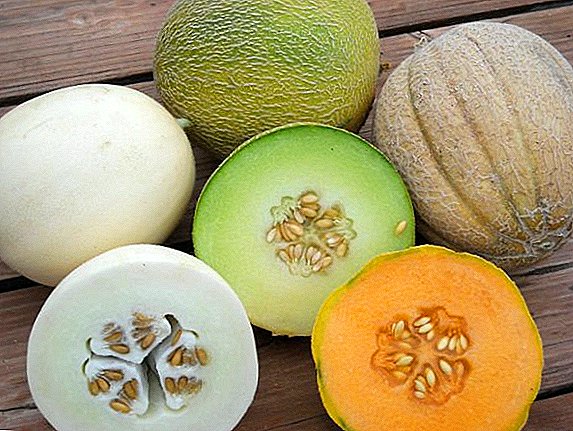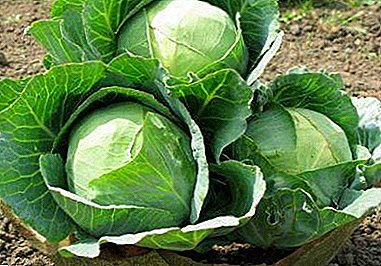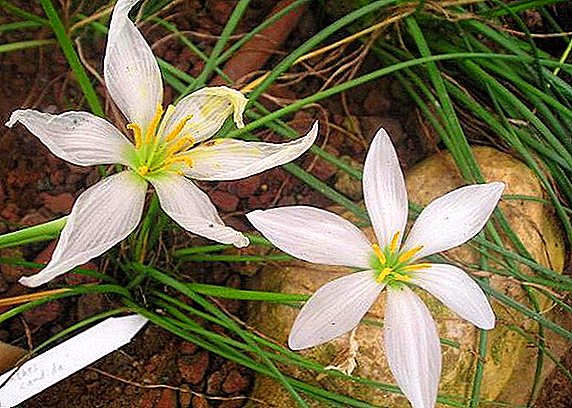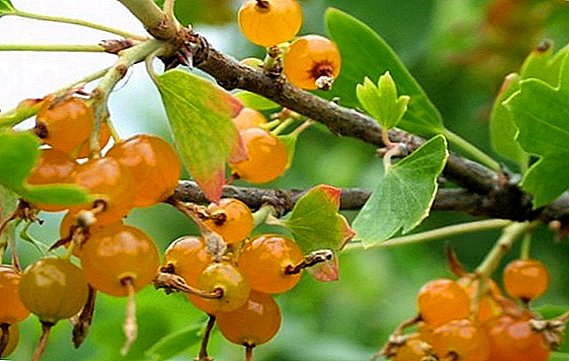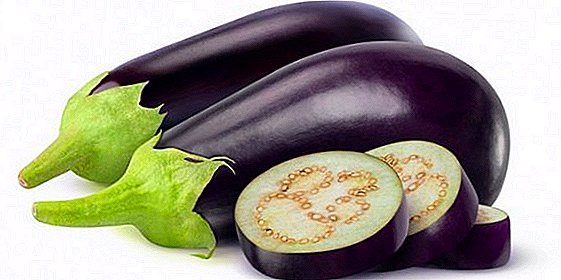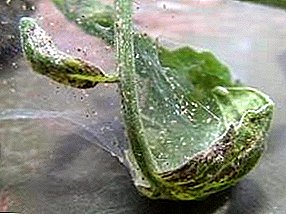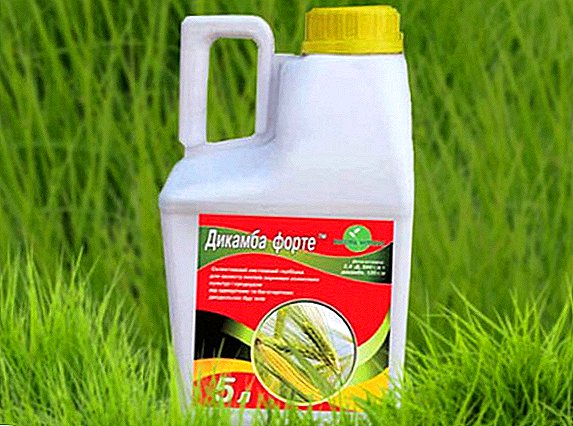
Weeds on hay and seed fields, as well as on lawns, cause a lot of trouble to land owners. Moreover, if unnecessary vegetation grows on cereal crops, yields are significantly reduced, and it becomes increasingly difficult to deal with debris every year. The problem can be solved with the help of the effective post-emergence herbicide of the systemic action "Dicamba Forte", the description of which we now consider.
Active ingredient and preparative form
Agronomists recommend the drug to combat more than 200 varieties of weed crops, including even difficult to eradicate perennials of the type of wheatgrass, birch, mountaineer.
This herbicide also effectively acts against wormwood, milkweed, quinoa, clover, buttercup, cornflower, ragweed, thistle, and Hogweed. Often used "Dicamba" to improve pastures.
 A characteristic feature of the herbicide is a pronounced systemic effect, which becomes possible due to dichlorophenacetic and dicamba acids, the concentration of which corresponds to 344 g / l and 480 g / l. As a result of a complex chain of physico-chemical reactions occurs impact not only on the aboveground part of the weed, but also on its root system.
A characteristic feature of the herbicide is a pronounced systemic effect, which becomes possible due to dichlorophenacetic and dicamba acids, the concentration of which corresponds to 344 g / l and 480 g / l. As a result of a complex chain of physico-chemical reactions occurs impact not only on the aboveground part of the weed, but also on its root system.
Important! Buying toxic chemicals, beware of fakes. To avoid being caught by the scammers, carefully read the data on the packaging. On genuine products you will find holograms, information about the manufacturer and production assets, well-written instructions for use, date of manufacture and suitability. Often, fakes are characterized by clumsy translation or illiterate text, lack of trademarks and low prices. It is safer to make such purchases in specialized stores.The chemical pesticide goes on sale in the form of a water-soluble concentrate, in plastic bottles of 20 ml and in cans of 5, 10, 20 l. Please note that the herbicide "Dicamba Forte" has parallel names: "Meliben", "Velzikol", "Dianat", "Banvel-D", "Baneks".

Drug benefits
Of the many means to combat weed cultures "Dicamba" stands out:
- rapid digestibility of plant fibers, which occurs equally through foliage and stems, and through weed roots;
- toxicity to a wide range of weed vegetation;
- prolonged herbicide exposure that lasts about 5 weeks;
- complete decomposition in the soil that occurs during the growing season of the crop;
- lack of influence on subsequent plants and crop rotation processes;
- lack of resistance to pesticides from other chemical classes;
- lack of phytotoxicity for cultivated crops and hay crops;
- good compatibility with other herbicides, which allows the use of the drug in tank mixtures;
- loyalty to bees, as well as safety for humans and animals;
- convenient preparative form;
- economy in use.
Did you know? European farmers use the product for more than 40 years. About it became known in the 70s, when the Swiss company "Velzikol ke-mikl corporation" announced its new development. Today, in many countries of the world, this product leads in terms of imports.

Mechanism of action
The effectiveness of the drug is possible due to the inhibitory effect of the active components on the development of cells and their division. When particles of a substance enter tissue fibers, blocking photosynthesis and weed growth. As a result of the failure of protein and lipid metabolic processes, the root system and, accordingly, the stems die.
The impact of the herbicide is noticeable within a week, a maximum of one and a half, after application. This nuance is more dependent on weather conditions in the period after treatment and the characteristics of weed crops.
Learn also about the use of other herbicides, such as "Lontrel Grand", "Lornet", "Caribou", "Stomp", "Titus", "Stellar", "Legion", "Zeus", "Puma Super", "Totril" , "Galera", "Biathlon", "Harmony".
Experts warn that high moisture and heat contribute to rapid microbiological decomposition. But in an acidic environment, this chain of reactions takes much longer. In a micronutrient-enriched, well loosened substrate with an alkaline reaction, the visual impact of the herbicide is already noticeable after 14 days, and on depleted clogged fields during rainy cold weather, the decomposition of the active substances can take a half a year or more.

When and how to spray
The specific difference of "Dicamba Forte" from other pesticides of this group is a weak effect on the grass weeds during the tillering period, therefore the herbicide should be used, strictly adhering to the instructions for use and the recommended spraying time.
Leading agronomists advise planning to sprinkle land in the spring, when cereal plants are in the tillering stage, annual weeds thrown out by 2-4 leaves, and perennial reached 15 centimeters height.
On corn plantations it is best to use "Dicamba" when 3-5 leaves will develop on the stems. And fodder grasses can be sprayed both in spring and in autumn, depending on the growing season of weeds.
Regardless of the type of culture and weather factors, all work on the field should be carried out in the morning or evening. At the same time, it is important that there are no strong gusts of wind, because in this case there are great risks of the chemical entering neighboring plants.
Did you know? If the weeds have grown in your garden, in the fight against them, you can apply the "grandmother's recipes", which consist in the use of vinegar and salt. For severely neglected cases, a tablespoon of salt and a glass of vinegar will be needed per liter of water. The number of components can be adjusted depending on the degree of contamination.

Some farmers mix the herbicide with other drugs. This is done for a comprehensive impact on crops and at the same time protecting them from diseases, pests and unnecessary vegetation. Such a decision is welcomed by experts, as it saves time and resources involved.
But at the confluence of "Dicamba" with drugs from the sulfonylurea group, the effect of herbicides is minimized. It is best to connect Triazin, Glyphosat, Aminka, Batu, Argument, MM 600, Ether, Maitus, Grozny for tank sprays.
If everything is done on time and in accordance with the attached instructions, one seasonal processing will be enough to eliminate the problem.
Important! Despite the low level of toxicity "Dicamba" for people on the fields treated with herbicide Grazing is strictly prohibitedas well as hay harvesting.
Solution consumption rate
According to the recommendations of the producers, per hectare of grasslands it is necessary to spend 1.5-2 liters of the drug. Moreover, the treatment should occur 40 days before harvesting grass.
But under the fierce and winter varieties of wheat, barley and rye, the consumption of the drug per hectare of a sown area is 0.15-0.3 l. On corn fields, the dosage is recommended to be increased to 0.8 liters per hectare, and on the lands left under steam, the norm is from 1.6 liters to 3.5 liters. 
The required amount of substance in each case depends on the degree of weed growth and their viability. Therefore, the range of recommended dosages is different.
Did you know? Many modern herbicides and pesticides are much safer than common, it would seem, innocuous, medicine and some food. For example, LD50 (the dose of the drug that causes death in 50% of the animals studied) in caffeine is 200 mg / kg, in table salt - 3750 mg / kg, aspirin - 1750 mg / kg, and in some pesticides - only 5000 mg per kg.
Security measures
"Dicamba" is slightly toxic substance for warm-blooded individuals (hazard class 3). Even if a cat weighing 10 kilograms eats about 20 grams of toxic chemicals, it will not die. But possible poisoning, accompanied by the appearance of various tumors.
On the skin, its symptoms are mild. In such cases, there is a suppression of receptor activity, conditioned reflex activity, which ultimately leads to inhibition of all actions in the body.
With severe intoxication may be a lack of coordination of movement. Fatal outcome, as a rule, occurs after 48 hours, and in individuals that have been saved, the pronounced symptoms disappear only on the third day.
It is characteristic that if we nourish the grass sprinkled with toxic chemicals to cows, a specific indefinite odor and an astringently bitter taste will prevail in the milk. If the herbicide hits the water source for 12 days, a similar pattern will be observed. 
Important! In the green mass, residues of the herbicide persist for one and a half months.To avoid risks and their unpleasant consequences, be vigilant. When working with the product, protect yourself with overalls, rubber boots and gloves, headgear, goggles and a respirator. In the process of preparing the working solution and its distribution on the land plot, it is forbidden to take food and drink. It is advisable to limit the contact of the hands with mucous membranes.
If the substance comes into contact with the skin or eyes, it must be washed off with plenty of running water. If any dose is accidentally swallowed, immediately flush the stomach and take a suspension of activated charcoal. The victim should be as much as possible in the fresh air. If signs of indisposition do not disappear, immediately call an ambulance brigade.
After work the released container is subject to utilization in places specially designated for this purpose. Water after washing spray tanks can not be poured into reservoirs: if the source gets more than 150 mg / l of water, its sanitary regime will be broken.
Storage conditions
According to the recommendations of the developers, the sealed herbicide can be stored for up to 4 years from the date of issue. To do this, you need to find a dark and safe place, away from food and medicine, as well as to limit access for children and animals.

Important! According to sanitary and epidemiological standards, storage facilities for pesticides should be located within 200 m from residential buildings, ponds, farms and other buildings of any purpose.
The generally accepted rules for storage of pesticides state that the herbicide should not stand on the floor, but on the shelf. The container must be tightly sealed so that the product does not spill or evaporate.
Remains of the working solution are not intended for long-term savings. Therefore, when preparing a liquid, correctly calculate the required amount of the substance.
In the fight against weeds, as shown by the experience of European farmers, "Dicamba" is simply irreplaceable. To save on pesticides and other resources involved, the main thing is to start caring for the field in a timely manner. Then the harvest will be high, and the land will be fertile.



